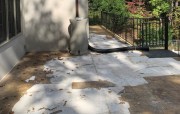Courtesy of Big River Indutries
Atlanta-based Big River Industries produces high-quality expande…
Courtesy of Big River Indutries
Atlanta-based Big River Industries produces high-quality expande…
Owner: Illinois State Tollway Highway Authority
Concrete Producer: Super Mix Inc., Hampshire, Ill., plant
Contractor: Acura, Inc., Bensenville, Ill.
LWA Supplier: Big River Industries, Atlanta
Concrete, especially high-performance concrete, is designed to limit permeability and reduce chloride ingress, but these properties also limit the ability of externally applied curing water, typically placed on top of the concrete after it has been mixed and poured, to reach the concrete’s interior.
“Conventional curing may only penetrate a few millimeters into the concrete,” says Speck. Once it sets, chemical shrinkage continues in the cementitious paste as hydration progresses, and creates pores within the concrete. These unfilled pores create stress, which causes shrinkage.”
IC provides additional water throughout the concrete, so more of the pores remain water-filled, minimizing stress and strain development. This reduces or eliminates early age cracking of the concrete and promotes maximum hydration, which can contribute to increased strength.
Although the concept of IC may still be somewhat new to many in the concrete industry, since 2003, more than 2 million cubic yards of IC normal weight concrete, including 1.3 million cubic yards in low slump pavements, have been placed. Projects using high-performance concrete are benefiting from IC as well.
IC results in only slightly higher initial costs. However, when considering the extended service life, these costs are far outmatched by the value IC provides. Predictions based on 2010 research by Daniel Cusson of the National Research Council Canada maintain that service life of a normal concrete deck is 22 years with a present value life cycle cost of $783 per square meter, while a high-performance concrete deck has a projected service life of 40 years with a life cycle cost of $472 per square meter, a 40% reduction. A high-performance concrete deck with IC has a predicted service life of 63 years with a life cycle cost of $292 per square meter, a 63% reduction compared to a normal concrete deck.
“The ASTM standard that was approved in 2012 has been substantiated in a variety of civil engineering projects, such as parking lots, roads, bridges, and water and sewage treatment tanks, and even for residential driveways,” says Speck.
During the last year, the use of the standard has begun to impact concrete projects contracted by the U.S. Federal Highway Administration and state departments of transportation, as well as architects, contractors, producers, and environmental, structural, and civil engineers.
For more information on internal curing with LWA, visit here.
Don Eberly is president and CEO of Eberly & Collard Public Relations.E-mail deberly@eberlycollardpr.com. This article was originally published in The Concrete Producer, CC’s sister publication.
In January 2013, the Illinois State Tollway Highway Authority solicited bids for the I-90 bridge that crosses U.S. Route 20 in Hampshire, Ill. The specification included a provision for high-performance concrete mix designs for the concrete superstructure, with the primary goals of reducing or eliminating cracking in the bridge decks by drastically reducing shrinkage, and increasing the service life of the structures.
The performance-based specification allowed Super Mix to develop a mix design that met the various criteria set forth in the special provision. The producer selected Riverlite, an expanded lightweight clay aggregate (LWA) in conjunction with a high-range water reducer, shrinkage reducing admixture, hydration stabilizer to produce a mix design that met the various criteria specified by the highway authority.
Super Mix technicians conducted both laboratory and field test batches on the mix design with the assistance of Matthew D’Ambrosia of CTLGroup in Skokie, Ill. The team replaced a portion of sand with the Riverlite LWA to make available absorbed water for internal curing purposes.
By using Riverlite LWA, Super Mix was able to develop a mix that met the performance requirements of the Tollway Authority. The LWA was soaked with a sprinkler for several days and then allowed to drain for a day to reduce the free moisture on the surface of the material. After the stockpile had been thoroughly mixed, the concrete was batched with consistent slumps out of the plant.
A new standard is created after research shows the essential role lightweight aggregate carries for internal curing.
After years of intensive research with outstanding results, the aggregate industry began to look into the need for an ASTM specification. Dale Bentz of the National Institute of Standards and Technology, wrote the first draft of a standard specification in 2007. The aggregate industry reviewed and edited the Bentz draft, and debated whether to incorporate it into the existing ASTM Standard C330, Specification for Lightweight Aggregates for Structural Concrete, or to create a new standard from scratch. In December 2010, a task group was appointed to prepare a ballot item for voting in ASTM Subcommittee C09.21 – Lightweight Aggregates and Lightweight Concrete.
By July 18, 2011, the subcommittee was ready to submit version 9 of the draft standard to ASTM for the first ballot cycle. Less than a year later on June 15, 2012, after four more versions, one subcommittee ballot and two concurrent ballots, ASTM notified John Ries of the Expanded Shale, Clay and Slate Institute that the document was officially approved, with the designation ASTM C1761-12, Standard Specification for Lightweight Aggregate for Internal Curing of Concrete. Long-time industry professionals were glad to see the practice that they had known held value for years finally come to standard fruition.


